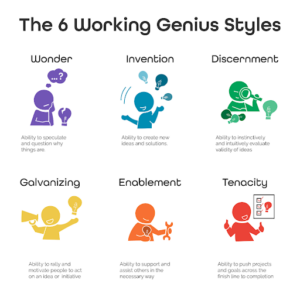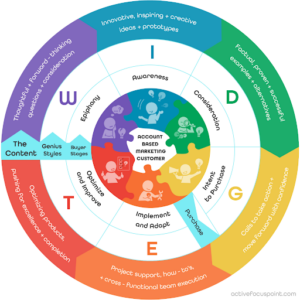Unidentified but Personalized Content for Account-Based B2B Purchasing Groups. Interlacing the customer buyer stages utilizing Patrick Lencioni’s Six Types of Working Genius styles.
Unidentified but Personalized Content for Account-Based B2B Purchasing Groups. Interlacing the customer buyer stages utilizing Patrick Lencioni’s Six Types of Working Genius styles.
Guest writer Roy Lapa uses Lencioni as his benchmark in “Unidentified but Personalized Content for Account-Based B2B Purchasing Groups. Interlacing the customer buyer stages utilizing Patrick Lencioni’s Six Types of Working Genius styles.”
A content journey map may help you create and share relevant messaging with your target audience at each stage of the buyer’s journey. Further, by aligning your content journey map with Patrick Lencioni’s working genius styles, you provide interesting and effective media to guide and convert unidentifiable decision influencers. Although different types of working genius styles exist among various roles throughout your customer’s company, one needs to remember that the working genius style remains focused on an individual rather than their positional title. Hence, the material created with the working genius style in mind will appeal directly to the individual. In the likely event that account-based marketers do not know all the key decision-makers within a B2B buying committee, this method provides a workaround for reaching the right individuals.
The following table contains a brief overview of the 6 working genius types.
Everyone has two strong geniuses based on what comes naturally to them and what brings them joy. When developing content, I suggest focusing on one working genius style, or perhaps two when located adjacent to each other. For example, to write a white paper for your customers about acquiring the most out of a semi-automatic intelligent machine, tailor it to appeal to the enablement and tenacity types.
Why produce B2B content according to a person’s working genius type?
- Recent changes in the workplace: from a highly structured approach to a matrix, cross-functional, team approach.
- Agile work environments allow more voices to be heard.
- B2B customers use decision-making groups that span across multiple departments.
- Innovative and direct, it appeals to everyone’s working genius style, regardless of title.
- In high-value purchases, roles and titles matter less.
The following illustration shows the first two stages of the buyer journey and the aligned persona types corresponding with Patrick Lencioni’s working genius styles. Keep in mind the importance of positioning the content to appeal to the individual’s natural working styles, not their title.
This approach will provide you, the service provider, insight regarding the type of story to produce and consequently the type of media channels to focus on. Irrespective of the buyer stage, various types of media production (video, written, digital, social, whitepapers, case studies) may be appropriate.
ABM marketers can create content that synchronizes their messaging with the working genius type (or persona) and the corresponding buyer stage.
Conclusion
- Six individual working genius styles (personas) determine your content, not their job title. The persona map aligned to the buyer stage will appeal to all relevant people in medium-to large-sized account for each business situation. (B2B buying groups)
- Consider different working genius types that may be involved with the company’s decision-making process. (Smaller organizations)
- In medium- to large-sized organizations evaluating substantial investments, there are typically more than eight individuals involved in the purchasing decision. All genius working styles (personas) will likely be involved.
- Media selection (mix, types, frequency) must match the working genius type (persona) and buyer stage.
Works Cited
Lencioni, Patrick M. “The 6 Types of Working Genius.” A Better Way to Understand Your Gifts, Your Frustrations, and Your Team, Matt Holt, 2022.



